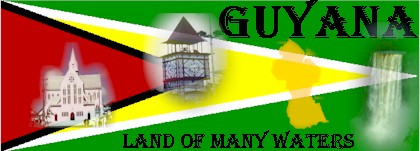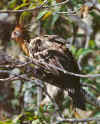











| The National Flag of Guyana, "The Golden Arrowhead" has five colours: green, gold, red, black and white. The principal colours of the flag is green, gold and red. The flag has the design of two triangles one within the other issuing the same base. The background of the flag is green, representing the agricultural and forested nature of Guyana. The white border represents the river and water potential. The gold arrow represents Guyana's mineral wealth and the black border, the endurance that will sustain the forward thrust of the Guyanese people. The red of the flag represents the zeal and dynamic nature of nation-building which lies before the young and independent Guyana. |  |
 |
Guyana's national Coat-of-Arms is a set of different designs made by three Guyanese artists. The Amerindian head-dress symbolizes the Amerindians as the indigenous people of the country. The two diamonds at the side of the head-dress represent the country's mining industry. The helmey is the monarchial insignia. The two jaguars holding a pick axe, a sugar cane and a stalk of rice symbolize labour and the two main agricultural industries of the country: sugar and rice. The shield which is decorated with the national flower, is to protect the nation. The three blue wavy lines represent the many waters of Guyana. The National Bird at the bottom of the shield represents a rare bird found principally in this part of the world and also the rich fauna of Guyana. The streamer below the shield bears the Nation's Motto "ONE PEOPLE, ONE NATION, ONE DESTINY". |

The Victoria Regia, a water lily, was discovered by Robert Schomburgk, a German Botanist in 1837, while leading an expedition into the interior of what was then British Guiana. In its native habitat of Tropical America, the plant is perennial. It grows in 4 to 6 feet of water, the base of the stem being down in soft mud. The largest flowers can measure 10 inches to one foot in diameter. When first open, they are white with a sweet smell rather like a ripe fruit; by the second day they are fully expanded and a deeper pink; by the third day they start to wither.

The Hoatzin or Canje Pheasant is known as the National bird of Guyana. The adult Hoatzin is about 22 inches long from beak to tail. It's colour is reddish-brown streaked with green. The under parts are pale brown. The feathers on its shoulders and sides are edged with creamy-white. There is a crest of very long feathers on its head which gives the bird an almost majestic look. The Hoatzin has a very short and thick beak, and the skin around the crimson eye is a pale blue colour. The bird can be found in areas along the banks of the Berbice River and its tributary, the Canje Creek. The nesting period for the Hoatzin is usually from April to September.












